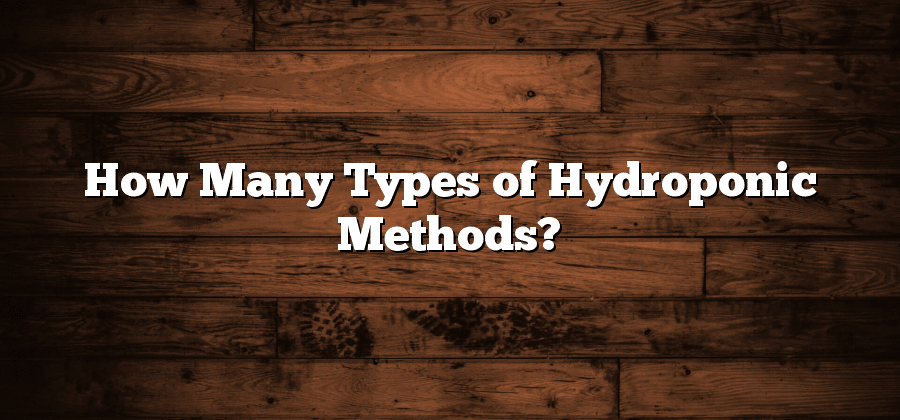What is Hydroponics and Its Benefits?
Hydroponics is a revolutionary method of growing plants that does not rely on soil. Instead, it utilizes a nutrient-rich water solution to deliver essential minerals and vitamins directly to the plant’s roots. By providing a controlled environment, hydroponics allows for optimal growth and development, resulting in healthier and more productive plants.
One of the biggest benefits of hydroponics is its ability to maximize crop yields. Without the limitations of soil quality, plants grown hydroponically can reach their full potential, producing larger fruits and vegetables. Additionally, the controlled environment of hydroponics eliminates the need for pesticides and herbicides, making it a more sustainable and environmentally-friendly option. Moreover, hydroponics can be practiced in any location, making it ideal for urban areas where suitable land for traditional farming may be scarce. With the ability to grow plants vertically and in compact systems, hydroponics offers a space-efficient solution that can yield higher outputs compared to conventional farming methods.
Traditional Hydroponic Methods Explained
Traditional hydroponic methods have been used for centuries to grow plants in water-based solutions, without the use of soil. One popular method is known as the Nutrient Film Technique (NFT). In this system, a thin film of nutrient-rich water is continuously circulated over the plant roots, providing them with a constant supply of nutrients. The plants are typically grown in long, narrow channels, with the roots dangling down into the flowing water. This method is highly effective for the cultivation of leafy greens and herbs, as it allows for efficient nutrient absorption and rapid growth.
Another commonly used traditional hydroponic method is Deep Water Culture (DWC). In this system, plants are suspended in nutrient-rich water with their roots fully submerged. Air stones or diffusers are used to supply oxygen to the root zone, ensuring that the plants receive adequate oxygenation. DWC is particularly advantageous for larger plants, such as tomatoes and peppers, as it provides a stable and well-balanced growing environment. The simplicity and scalability of this method make it a favorite among both hobbyists and commercial growers alike.
These traditional hydroponic methods offer several advantages over traditional soil-based gardening. First and foremost, they allow for precise control over nutrient levels, ensuring that plants receive the ideal balance of macronutrients and micronutrients. Additionally, by eliminating the need for soil, these methods minimize the risk of pests and diseases, making them a more sustainable and environmentally friendly option. Furthermore, by optimizing nutrient delivery and root oxygenation, traditional hydroponics can significantly increase plant growth rates, resulting in higher yields and faster harvests.
Nutrient Film Technique (NFT): A Detailed Overview
The Nutrient Film Technique (NFT) is a popular hydroponic method that is designed to provide a thin film of nutrient-rich water constantly flowing over the roots of the plants. In this system, plants are placed in channels or gutters, allowing the nutrient solution to flow continuously through these channels.
One of the main advantages of NFT is its efficient use of water and nutrients. Since the roots are constantly exposed to the nutrient solution, there is less wastage compared to other systems where excess water is drained away. This means that the plants can take up more nutrients, leading to faster growth and higher yields. Additionally, with NFT, there is better oxygenation of the roots since they are not submerged in water, ensuring optimal root health.
Deep Water Culture (DWC) Hydroponics Explained
Deep Water Culture (DWC) hydroponics is a popular and effective method of growing plants without soil. In this system, the plant roots are suspended in a nutrient-rich water solution, allowing for direct and continuous access to the essential elements needed for growth. The key feature of DWC is the use of an oxygenated reservoir that ensures the roots receive ample oxygen for cellular respiration, promoting healthy growth and preventing the roots from suffocating.
One of the main advantages of DWC hydroponics is its simplicity and ease of use. The system requires minimal setup and can be easily scaled up or down to accommodate different plant sizes and quantities. Additionally, DWC is a highly efficient method, as the plant roots directly absorb nutrients from the oxygenated water solution, eliminating the need for nutrient-depleting soil. This not only saves space but also allows for faster growth and higher yields. Furthermore, the added oxygen in the water promotes robust root development, leading to healthier and stronger plants.
Aeroponics: The Revolutionary Hydroponic Method
Aeroponics is a cutting-edge hydroponic method that is revolutionizing the way plants are grown. Unlike traditional methods that use a growing medium such as soil or water, aeroponics relies on air to deliver nutrients and moisture directly to the plant roots. This innovative technique suspends the plant roots in a mist or fog of nutrient-rich solution, allowing them to absorb nutrients and oxygen more efficiently.
One of the key benefits of aeroponics is its water efficiency. Since the plants are grown in a mist or fog, the amount of water required is significantly lower compared to traditional methods. This makes aeroponics an ideal solution for regions with limited water resources or for individuals who are conscious about their water consumption. Additionally, aeroponics eliminates the need for soil, reducing the risk of soil-borne diseases and pests. This not only improves the overall health of the plants but also decreases the need for pesticides and other harmful chemicals.






